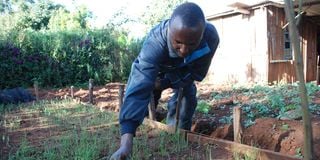Premium
When to transplant the onion seedlings

Peter Kimani at his onion seedlings nursery in Ngecha village in Limuru.
In our previous article, we looked at the management practices in the onion nursery bed. The seedlings are now ready for transplanting. This has taken about 45 days since the seeds were sown in the bed.
The seedlings should be pencil size in thickness and about 15cm long.
Timely transplanting is important as it prevents overgrowth of the seedlings, which also increases the cost of production.
Before transplanting, the farmer should ensure the land is well prepared and manure application is per the programme developed. The manure will help improve soil structure by introducing organic matter.
About 500g of manure was used per square metre as per the soil analysis guidelines. Three drip lines were aligned per bed.
At this point, farmer Desmond had already carried out hardening off to ensure the seedlings adapted to open field conditions.
Before transplanting, we ensured the lines were dripping water efficiently and had no leaks. The soil was well saturated with water. We used drip lines with emitters at an interval of 20cm.
After ensuring everything was in place, we prepared planting furrows at a spacing of 10cm by 15cm.
In line with our fertiliser plan, we added diammonium phosphate (DAP) into the soil at a rate of 15g per metre square. Following the fertiliser programme helps reduce the cost of production while ensuring efficient utilisation of nutrients.
The DAP was well mixed with soil in the furrows so as not to scorch the seedlings.
Alternatively, broadcasting can be used to apply fertiliser before planting.
This is by spreading the fertiliser on the bed randomly and mixing it with soil. However, this method results in fertiliser waste.
The seedlings were watered before uprooting from the bed. This ensures the rooting system is not affected.
Ideally, transplanting should be early in the morning or late in the evening when the weather is cool.
That gives the seedlings adequate time to recover before temperatures rise.
This is not always possible, especially if onions are planted in large quantities.
In this case, the farmer should ensure the soil has adequate moisture and water the seedlings immediately after transplanting.
Desmond hired labourers to do the transplanting. On average, a person should plant 60-90 square metres a day.
It is vital to plant along the driplines as that ensures seedlings receive enough water. Since onions are shallow-rooted, seedlings should not be deep planted.
One should avoid pressing the seedlings as it that would affect the root system.
After transplanting, we ensured the seedlings were getting water to prevent them from drying off.
We will look at the management practices after transplanting onions next week.





